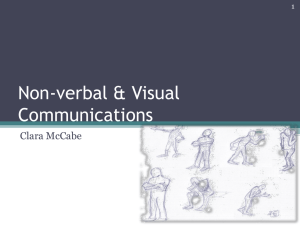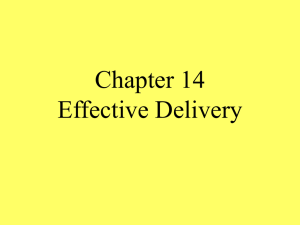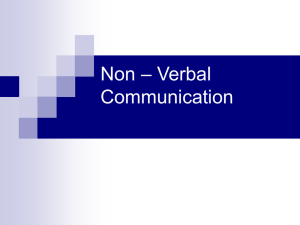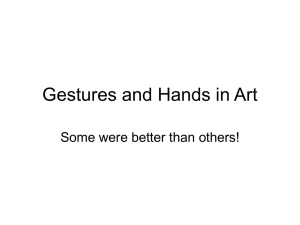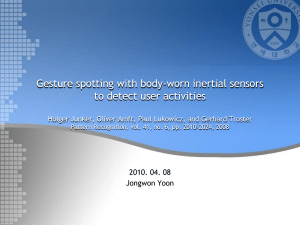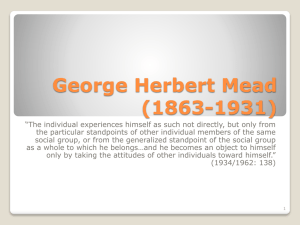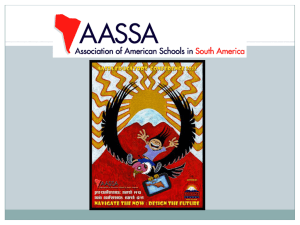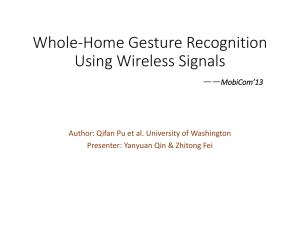Gesture
advertisement
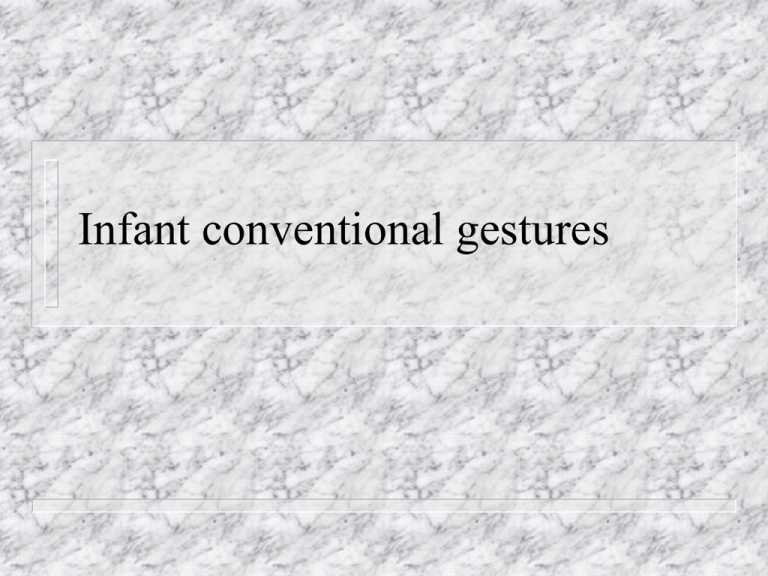
Infant conventional gestures Communication module Development of conventional gestures Assessing joint attention and its relationship to language Language development overview The role of experience – – Non-native phonemes Vocabulary growth 2 Questions Is infant communication necessarily verbal? What is the gestural advantage? What is the evidence that gestures have different social approach & instrumental functions? – – Do they change with age differently? Do they involve different expressive behaviors? What are anticipatory smiles? Do they increase with age? What predicts them and what are they predicted by? 3 Developmental overview Dyadic communication Infant Partner Direct, unmediated communication 2-6 months Triadic (referential) communication Infant Object Partner Communication about something – 9 months on 4 Why gestures are important Infant gestures are typically earliest conventional communications Infant gestures are tied to current and future language use Leavens, Hopkins, & Bard 2005 Pointing begins at 1 yr – – A point’s specific meaning is determined by location of pointer, object indicated, and communicative partner (referential triangle) Referential triangle believed to be foundational for development of speech Is it human-specific? – – Chimpanzees in captivity point, wild apes do not Is this meaningful? Bell Leavens, Hopkins, & Bard 2005 Captive chimpanzees exist within their own ecological framework Captive chimpanzees are selected from same gene pool as wild chimpanzees Is this attributable to epigenetic processes? – Yes – pointing does not rely on pre-occurring changes in the genome; novel phenotypes emerge in certain developmental contexts Bell Leavens, Hopkins, & Bard 2005 Not all children learn to point (Barai of Papa New Guinea) Pointing emerges only when an environment provides a function for that gesture – Referential problem space No other primate physically restrains its offspring to the degree that humans do Bell Chimps point, but how well? Comparison of 12-month-olds and adult chimpanzees Liszkowksi, Schäfer, Carpenter & Tomasello (2009) Pointing as a precursor to language Crucial construct Communicating about objects out of view Mattson 9 Requesters and Givers Training Two Conditions Absent Referent Occluded Referent Mattson 10 What are the differences? Mattson 11 Complexity of Communication Differences in complexity level in chimpanzees? Open vs. Fully Articulated Chimp Requesting Gesture Whatever works? Mattson 12 Definitions Gestures – Conventional gestures – Movements with meaning Movements with shared meaning Symbols – – – Signs that represent the world Distance between referent object and sign Which can be made with hand or mouth 13 Gestural development Working gestures (pointing, offering) – – Social gestures – – between 9 & 12 months; Performatives: wave bye-bye, shake head no, etc. Enacted or representational gestures (10 – 15 months) – – between 9 & 12 months; Get things done: request, name, offer begin with symbolic play include pretending to drink from a cup Symbolic gestures – represent things or events – – – emerge around the same time as first words (14-15 months) used to make requests, describe attributes, name objects degree of context-free representation varies Debate Is language a specific module in the brain? Or One manifestation of sophisticated intellectual capacity? 15 Language need not be verbal “A view of the child . . . endowed with special linguistic input and output devices is giving way to a view of the child as a creature equipped with ears and eyes and with various moving parts that can be harnessed to form the sounds and sights of its species communicative signals (StuddertKennedy, 1991, p. 89)” • http://www.babysigns.com/babysigns_research_symbolicge sturingarticle.shtml 16 Friend’s 11-month-old Has (hand) signs for: – – – more, bird, dog, (her first 3), nurse, eat, drink, potty, flower her – invention: sniffing, face scrunched, hat, sleep, cat (with word 'zaza’) • Myers (1999) Teach gestures to some at-risk populations What’s source of gestural advantage? 17 ‘Symbolic gesture versus words’ 37 infants approximately 11 months of age were exposed to a set of eight gestures by pairing the vocal word (for example, ``bird'') with the gesture (for example, arm-flapping) any time an opportunity arose. – – The families of these children were provided with toys and picture books that exemplified the objects. The development of symbolic use, both gesturally and verbally, was tracked via weekly interviews with the child's parents. 18 Gestural Advantage Infants of this age, provided with appropriate input, use enactive gestures to refer to objects and activities before they do so with words • Goodwyn & Acredolo, 1993 19 20 21 “Symbolic gesturing impacts early language development” 103, 11-month-old infants were divided into – – – – Sign Training group modeled symbolic gestures Non-intervention did not know about symbolic gestures Verbal Training group – controls for training per se Standard language tests at 15, 19, 24, 30, 36 months. “The results provide strong evidence that symbolic gesturing does not hamper verbal development and may even facilitate it. Susan W. Goodwyn, Linda P. Acredolo and Catherine A. Brown (2000) Journal of Nonverbal Behavior, 24, 81-103. 22 Symbol use: Referring to multiple exemplars The onset of symbol use in the gestural modality reliably preceded the onset of symbolic use in words. The time lag between gestural and verbal symbol use was rather small (less than 1.1 month) 23 Symbolic gestures in sign training children’s repertoires Drink: Thumb to mouth DS: To ask for bottle Cheerios: Index fingers to thumbs MR: To request more Cheerios Fish: Smacking lips together KA: To fish toy in tub and goldfish crackers Water: Rubbing palms together CH: With FISH gesture to fish in pond Book: Open/Close with palms AT: With MORE gesture to ask for another book 24 Deaf Signed motherese – Signed (manual) babbling Deaf infants exposed conventional sign language develop normally linguistically – Prolonged, exaggerated signs E.g. ASL Delays but evidence of idiosyncratic symbol used among deaf infants not exposed to a conventional sign language Quittner 25 Fig. 1. Scatter plots showing relations between (i) SES and child gesture at 14 months (top left), (ii) SES and parent gesture at child age 14 months (top middle), and (iii) parent gesture and child gesture (top right). M L Rowe, S Goldin-Meadow Science 2009;323:951-953 Published by AAAS Fig. 1. Scatter plots showing relations between (i) SES and child gesture at 14 months (top left), (ii) SES and parent gesture at child age 14 months (top middle), and (iii) parent gesture and child gesture (top right). M L Rowe, S Goldin-Meadow Science 2009;323:951-953 Published by AAAS References Messinger & Fogel, 1988 Venezia et al. Parlade et al. Striano 28



